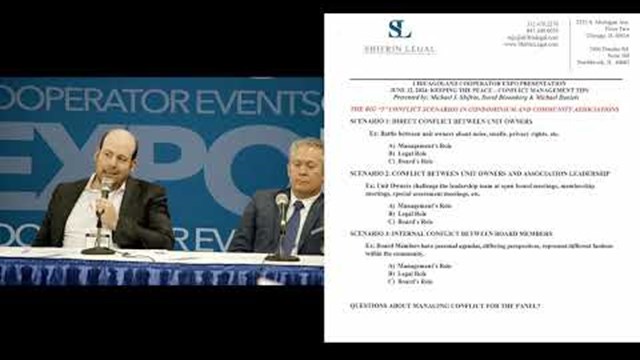Living in close quarters can—and often does—lead to conflict. In co-op, condo, and HOA communities, conflict can occur between residents, or between a resident and the board. And to complicate matters, a seemingly isolated conflict between residents may spill over to become a conflict between resident(s) and the board. What’s the key to resolving differences? Like the old British wartime poster advises: Stay calm and carry on.
A Dormant Volcano
In multifamily shared interest communities, resident dissatisfaction will often resemble a sleeping volcano. It appears quiet, but dissatisfaction is bubbling under the surface and eventually will reach a temperature and tension level that requires relief. Something has to give—and though the explosion likely won’t be as physically catastrophic as, say, Vesuvius, it can have profound legal, financial, and social consequences for the whole building or association.
“Key elements to achieving community harmony are organization and open communication,” says Skip Richardson, branch president, Associa Services of Florida. “As one can imagine, there are a plethora of personalities in a community which can easily lead to internal conflict. Topics such as the increase of monthly maintenance fees, community communication, how and where to spend reserve funds, and forecasting needs vs. wants are just a few of many potential powder kegs. While there is no ‘silver bullet’ that lets everyone see eye to eye, those communities with a clearly defined vision typically have greater ability to find common ground.”
The most common cause of conflict between boards and residents is disparity between residents’ expectations and what the association and its governing body can actually deliver. When owner expectations exceed what governing documents and rules allow, or what impressions the board may have given the residents, the burden is on the board to restore balance—through better communication, corrective action, or (more likely) a combination of both.
“The board can often manage residents’ expectations by holding open meetings and keeping the community fully informed of its actions,” says Paul Okonak, vice president of management services with Evergreen Property Management, an Associa Company located in Bedford, New Hampshire. “The latter can be accomplished through board newsletters, the posting of meeting minutes, and providing fully transparent financials. Welcoming new community members at board meetings and asking if there is anything they would like to know or speak about” can also go a long way toward demystifying board operations and improving board/resident relations.
“Being proactive can mitigate many potential conflicts,” agrees Jaime Sikorski, vice president of management for AKAM, a property management company with offices in New York City and Florida. “Annual or bi-annual goal-setting by the board is a helpful best practice. Not only does this keep the board on track, but they can go back to the goals when conflicts arise, making the decision based on helping move closer to that goal. Communicating these goals, or any impactful information surrounding the property or residents, will not only naturally enhance communication and transparency, but also provide further insights into the board’s priorities, accomplishments, and roadblocks.”
Communication Channels
When a resident has an issue with their board that may potentially cause conflict, what should they do? Email a board member? Send a letter? Confront the board at a meeting? Conversely, when the board or a member of the board has an issue with an association member, how should they approach the problem?
Douglas Weinstein, AKAM’s senior vice president for management in their Florida offices, suggests that “instead of a board member directly addressing an issue with a resident or vice versa, we recommend that they first attempt to resolve it through communication with the on-site manager. Many times, issues can be resolved this way, as they might have arisen from miscommunications or inaccurately conveyed information. As managing agents, we play a key role in finding resolutions. Part of our responsibility is to ensure that residents’ concerns are heard, complaints are acknowledged, and—ideally—matters are resolved before they are ever escalated.”
Matthew Carter, regional director for FirstService Residential in New Jersey, offers some do’s and don’ts for both boards and residents when tensions run high. “Listen actively,” he says. “Take the time to actively listen to the concerns and perspectives of all parties involved in the conflict. Create an environment where everyone feels heard and valued. Foster open and respectful communication. Encourage board members to express their opinions and concerns in a constructive manner. Seek common ground. Look for areas of agreement and common interests among conflicting parties. Finding common ground can be a starting point for resolving the conflict.”
Carter explains further that it’s critical to prioritize the community’s interests above those of individuals. That’s the board’s main responsibility to begin with. He also stresses that no one involved should react emotionally, and they should avoid responding to conflicts with anger or frustration. Tempting as they are in the moment, emotional reactions can escalate the situation and hinder productive resolution.
When approaching the board with complaints and questions, “kindness and politeness always win,” says Brandon Clayton, senior community manager for Associa Chicagoland. “In addition, I highly recommend attending board meetings on a regular basis to see what is happening in your community. Too often, a majority of owners with questions or complaints about their community fail to attend. If you can’t make a meeting, read the meeting minutes to see what occurred. Read the fiscal budget, and reach out to your management company with any questions. I—along with many managers—don’t mind scheduling a date and time to speak with homeowners about their community. We can answer all of their questions.”
Alternate Dispute Resolution
What happens when residents and boards can’t resolve their issues amicably on their own? Fortunately, there’s an avenue to try before getting lawyered up and seeing each other in court. It’s known as alternative dispute resolution, or ADR for short. In some cases it’s a voluntary option for disputing parties attempting to resolve their issue without litigating, but in certain places—New Jersey, for example—it’s mandatory for parties to attempt ADR prior to filing a lawsuit.
In the case of a dispute among common interest community residents and/or boards, the resident and the board will most often submit their respective positions, evidence, and rationale to a neutral mediator for review and recommendation for a fair resolution of the problem. In most cases, the mediator is an attorney, and his or her recommendation for resolution is non-binding. Another form of ADR, arbitration, is rarely used in these types of disputes, but is usually legally binding, with the arbitrator’s decision being final.
Management’s Role
As with most situations in shared communities, management must often walk a fine line. Managers are neither the owners of the property, nor the duly elected board; they’re there to execute the decisions of the board and to monitor the day-to-day operations of the property. In conflict situations, they can easily get caught in the crossfire.
“A manager’s role is part politics, part psychology, and part management,” says Weinstein. “Many disputes originate from the fact that new owners—or even existing ones—often neglect to thoroughly review their community’s governing documents. One of our recommendations for new residents or buyers is to meticulously read these documents. This step is of utmost importance, because many disputes arise due to residents being unaware that their actions are in violation of rules or regulations in the first place—so keep that in mind when approaching a conflict or difficult situation.
“Frequently,” he continues, “communities organize new resident orientations where board and management can engage with newcomers to provide a comprehensive overview of the association’s rules and regulations. We try to increase awareness of the rules as managing agents, because we see so many disputes rooted in a lack of understanding them in the first place. Overall in the context of condominiums or HOAs, both sides need to also remember that it is community living, which entails adhering to these established rules.”
Sikorski stresses that “the same advice applies for residents as it would to board members. Whenever possible, take emotion out of the conversation. In many cases, the board members themselves are neighbors and experiencing similar personal concerns, but they’re tasked with making decisions for the overall benefit of the property. Additionally, before escalating, identify if a concern or grievance is property-wide or an individual issue, as this can help frame the resolution. Keep focus on the issue at hand and avoid making personal or overarching assumptions of the board or its members.”
Okonak offers an interesting view of potential conflict situations. “Residents typically feel wronged in some manner by the board, association, or management when they color outside the lines. It usually revolves around one’s personal lifestyle choices versus the mandated compliance of living in a planned community. Hopefully, this never results in a personal vendetta or attack on anyone. Most residents remember that when they moved into a managed community, they willingly agreed to abide by its existing living standards. I have lived in managed communities for almost 40 years, and when folks ask me, ‘How can you stand to live in a community with those rules?’ I reply that I did my homework first. I agreed to comply with those rules before I purchased, and they are rules that I can live with and the expectation is that my neighbors will as well.”
In the end, community living is different by definition from private home ownership. You, as the unit owner, are not necessarily the king or queen of your castle. And conflict will inevitably arise. It’s critical to remember: stay calm and carry on.










Leave a Comment